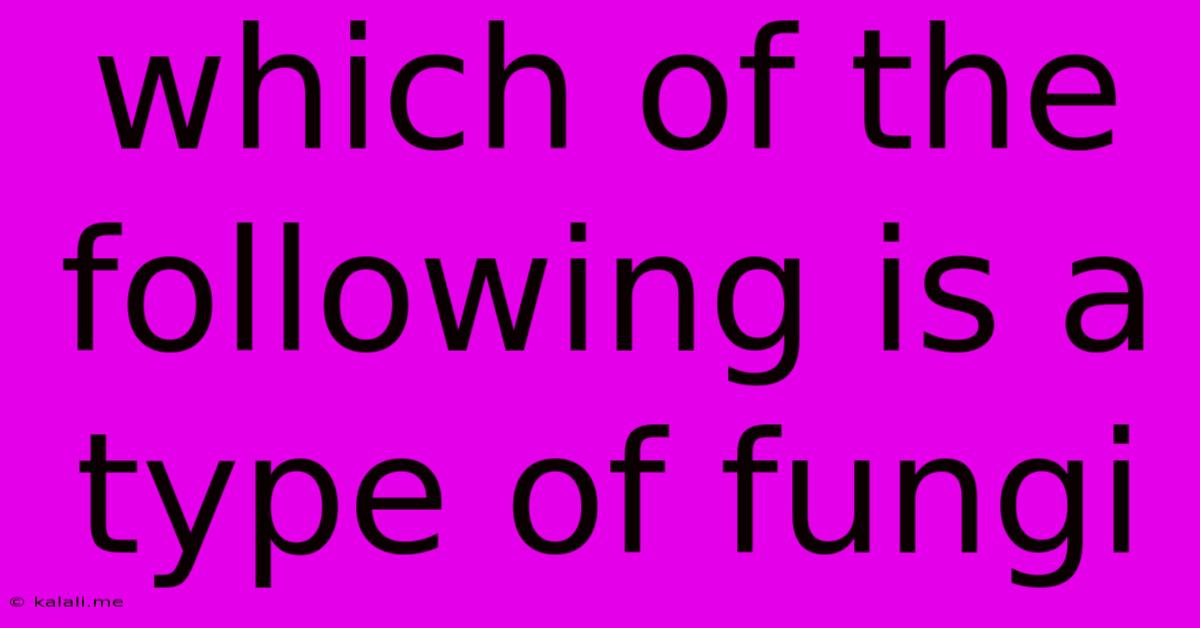Which Of The Following Is A Type Of Fungi
Kalali
Jun 15, 2025 · 3 min read

Table of Contents
Which of the Following is a Type of Fungi? Understanding the Fungal Kingdom
Fungi are a fascinating and diverse kingdom of life, often misunderstood and lumped together with plants. However, fungi are distinct organisms with unique characteristics and a crucial role in many ecosystems. This article will delve into the characteristics of fungi and help you identify which of several options might correctly represent a type of fungus. Understanding fungal diversity is key to appreciating their ecological importance and potential applications in various fields.
What are Fungi?
Before we delve into specific examples, let's establish some foundational knowledge about fungi. Fungi are eukaryotic organisms, meaning their cells contain a membrane-bound nucleus and other organelles. Unlike plants, they lack chlorophyll and are therefore heterotrophic, meaning they obtain their nutrients by absorbing organic matter from their environment. This absorption usually occurs through specialized structures called hyphae, which form a network known as mycelium. Many fungi reproduce through spores, tiny reproductive units that can be dispersed by wind, water, or animals. Key characteristics that distinguish fungi from plants and animals include their cell walls made of chitin (not cellulose like plants), their absorptive nutrition, and their ability to produce spores.
Types of Fungi:
The fungal kingdom is incredibly diverse, encompassing a vast array of species with varying morphologies, lifestyles, and ecological roles. Some common groups include:
-
Yeasts: These are single-celled fungi that reproduce asexually through budding. They are crucial in baking and brewing, fermenting sugars to produce carbon dioxide and alcohol. Examples include Saccharomyces cerevisiae, commonly used in bread making.
-
Molds: These are multicellular fungi that often form fuzzy colonies on decaying organic matter. They play an essential role in decomposition and nutrient cycling. Penicillin, a crucial antibiotic, is derived from a type of mold.
-
Mushrooms: These are the fruiting bodies of certain types of fungi, representing only a small portion of the entire organism (the mycelium). Many mushrooms are edible, while others are highly toxic. Examples include the common button mushroom (Agaricus bisporus) and the poisonous death cap (Amanita phalloides).
-
Mycorrhizae: These are symbiotic fungi that form associations with plant roots. They enhance nutrient uptake for the plant, while the plant provides the fungus with carbohydrates. This mutually beneficial relationship is vital for the health and growth of many plants.
-
Lichens: These are composite organisms formed by a symbiotic relationship between a fungus and an alga or cyanobacterium. The fungus provides structure and protection, while the alga or cyanobacterium produces food through photosynthesis. Lichens are often found in harsh environments.
Determining if Something is a Fungus:
To determine whether a specific organism is a fungus, consider these key features:
- Cell structure: Does it have a cell wall made of chitin?
- Nutrition: Does it obtain nutrients by absorption rather than photosynthesis?
- Reproduction: Does it reproduce via spores?
- Morphology: Does it exhibit characteristics consistent with yeasts, molds, mushrooms, or other fungal structures?
Without knowing the specific "following" options in your question, it's impossible to definitively identify which one is a type of fungus. However, by using the information provided above, you can assess the characteristics of any given organism and determine if it belongs to the fungal kingdom. Remember to look for the presence of chitin cell walls, absorptive nutrition, and spore production as key indicators.
Latest Posts
Latest Posts
-
The Atomic Mass Number Is Equal To
Jun 15, 2025
-
Polar Moment Of Inertia Of Square
Jun 15, 2025
-
Which Of The Following Represents A Quantitative Research Design
Jun 15, 2025
-
Which Of The Following Is Not A Fundamental Quantity
Jun 15, 2025
-
Which Of The Following Is Not A Dimension Of Quality
Jun 15, 2025
Related Post
Thank you for visiting our website which covers about Which Of The Following Is A Type Of Fungi . We hope the information provided has been useful to you. Feel free to contact us if you have any questions or need further assistance. See you next time and don't miss to bookmark.